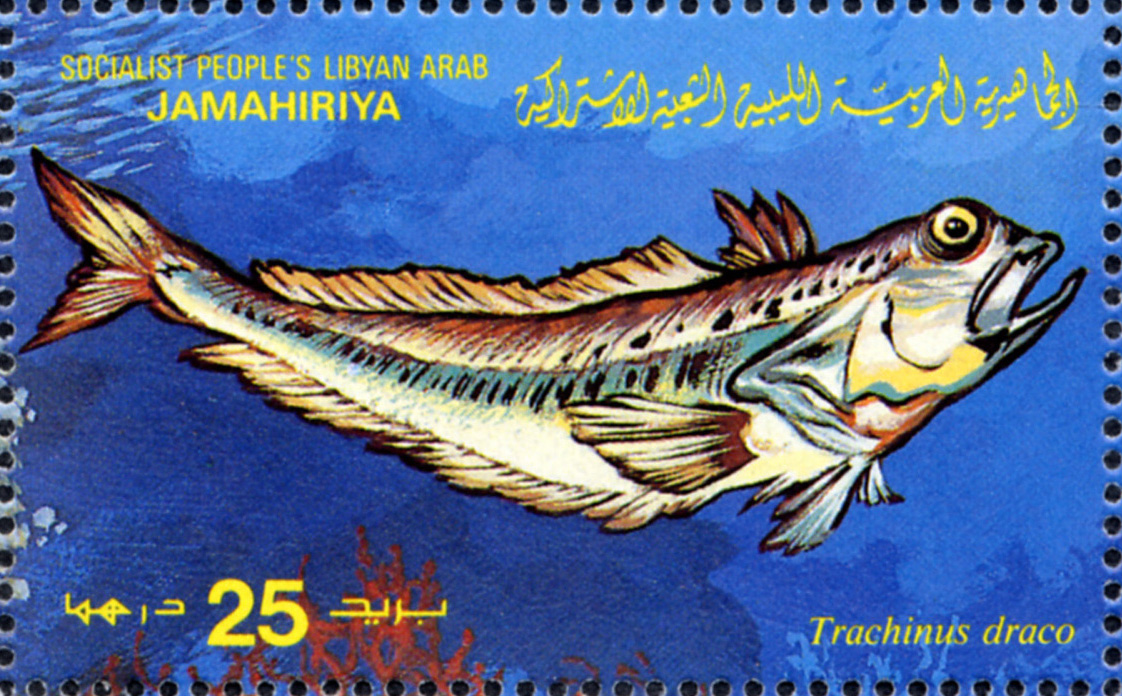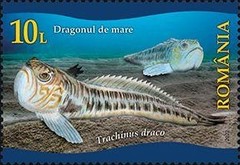Trachinus draco Linnaeus, 1758

(Da: it.wikipedia.org)
Phylum: Chordata Haeckel, 1874
Subphylum: Vertebrata Lamarck J-B., 1801
Classe: Actinopterygii Klein, 1885
Ordine: Perciformes Bleeker, 1859
Famiglia: Trachinidae Rafinesque, 1815
Genere: Trachinus Linnaeus, 1758
Italiano: Tracina drago
English: Greater weever
Français: Grande vive
Deutsch: Gewöhnliches Petermännchen
Español: Pez escorpión, Pez araña
Descrizione
Ha il caratteristico aspetto delle tracine con larga bocca rivolta verso l'alto, due pinne dorsali di cui la seconda lunga e la prima molto breve di colore nero, occhi sporgenti posti sulla sommità della testa e pinne pettorali trapezoidali ed ampie. Sull'opercolo branchiale si trova una lunga spina velenifera. La livrea è bruna sul dorso e chiara sul ventre con numerose linee oblique azzurre e gialle. La testa è maculata di scuro. La lunghezza può raramente raggiungere i 40 cm. Predatrice, si nutre di pesci e di altri animaletti che uccide con le spine velenose della prima pinna dorsale e dell'opercolo. La riproduzione è estiva. Le uova e le larve sono pelagiche. Passa gran parte del suo tempo infossata nella sabbia da cui fuoriescono solo gli occhi. Appena passa una preda mostra una insospettabile agilità lanciandosi velocissima per trafiggerla in pochi attimi con le spine velenose. Si cattura in gran numero sia con le reti che con lenze di ogni tipo, armate sia con esche naturali che artificiali. Le carni sono bianche e saporite, i piccoli esemplari di solito finiscono nelle zuppe mentre quelli grandi si possono cucinare arrosto o al forno. Occorre fare attenzione quando si puliscono questi pesci perché le spine velenose rimangono attive anche quando l'animale è morto. Le spine opercolari e della prima pinna dorsale sono velenifere e possono provocare punture dolorosissime anche se l'intossicazione raramente assume carattere di gravità. Si può essere punti sia camminando in acqua bassa (ma di solito si tratta della specie Echiichthys vipera che frequenta ambienti a piccolissima profondità) che slamando un pesce pescato o perfino pulendo un esemplare acquistato al mercato. È raramente successo che abbia deliberatamente aggredito subacquei che si erano avvicinati troppo. Per alleviare il dolore si consiglia di mettere la parte colpita in acqua o sabbia più calde possibile e di rivolgersi ad un medico.
Diffusione
È diffuso nell'intero Mediterraneo e nel mar Nero nonché sulle coste atlantiche tra la Norvegia (dove è raro) ed il Marocco. Nei mari italiani è molto comune. Vive su fondi sabbiosi di solito in acque basse, tra 5 e 20 metri di profondità ma può spingersi fino ai 100.
Sinonimi
= Trachinus lineatus Bloch & Schneider, 1801.
Bibliografia
–Carpenter, K.E.; Smith-Vaniz, W.F.; de Bruyne, G.; de Morais, L. (2015). "Trachinus draco". IUCN Red List of Threatened Species. 2015.
–ORDINES, F.; FARRIOLS, M.T.; LLEONART, J.; GUIJARRO, B.; QUETGLAS, A.; MASSUTÍ, E. (26 September 2014). "Biology and population dynamics of by-catch fish species of the bottom trawl fishery in the western Mediterranean". Mediterranean Marine Science. 15 (3): 613.
–Custovic, Selma; Vrgoc, Nedo; Isajlovic, Igor; Krstulovic Šifner, Svjetlana; Piccinetti, Corrado (2015). "Distribution and Population Structure of Greater Weever, Trachinus draco (Linnaeus, 1758.), in the Northern and Central Adriatic Sea". Naše More. 62 (1): 20-24.
–Russell, Findlay E.; Emery, Jerry A. (November 1960). "Venom of the Weevers Trachinus Draco and Trachilvus Vipera". Annals of the New York Academy of Sciences. 90 (3): 805-819.
–Davies, R S; Evans, R J (1 March 1996). "Weever fish stings: a report of two cases presenting to an accident and emergency department". Emergency Medicine Journal. 13 (2): 139-141.
–Valentin, Claus (1986). Faszinierende Unterwasserwelt des Mittelmeeres : Einblicke in die Meeresbiologie küstennaher Lebensräume (2. Neudr. ed.). Pisa [u.a.]: Pacini.
–Müller, Horst (1987). Fische Europas (2. Aufl. ed.). Leipzig: Neumann.
–Neumann, Volker (2005). Mittelmeer-Atlas : Fische und ihre Lebensräume (1. Aufl. ed.). Melle, Germany: Mergus, Verl. für Natur- und Heimtierkunde Baensch.
–Ak, Orhan; Genç, Yasar (1 January 2013). "Growth and reproduction of the greater weever (Trachinus draco L., 1758) along the eastern coast of the Black Sea". Journal of Black Sea / Mediterranean Environment. 19 (1).
–Santos, M N; Saldanha, Hugo Jorge; Garcia, Alexandra (2002). "Observations on by-catch from a tuna trap fishery off the Algarve (Southern Portugal)" (PDF). Collective Volume Scientific Papers ICCAT. 54 (5): 1726-1732.
–Šantic, M.; Pallaoro, A.; Rada, B.; Jardas, I. (August 2016). "Diet composition of greater weever, (Linnaeus, 1758) captured in the eastern-central Adriatic Sea in relation to fish size, season and sampling area". Journal of Applied Ichthyology. 32 (4): 675-681.
–Kruschel, Claudia; Schultz, Stewart T. (July 2012). "Use of a lure in visual census significantly improves probability of detecting wait-ambushing and fast cruising predatory fish". Fisheries Research. 123-124: 70-77.
–Bagge, Ole (September 2004). "The biology of the greater weever () in the commercial fishery of the Kattegat". ICES Journal of Marine Science. 61 (6): 933-943.
–d’Elbée, Jean; Castège, Iker; Hémery, Georges; Lalanne, Yann; Mouchès, Claude; Pautrizel, Françoise; D’Amico, Frank (April 2009). "Variation and temporal patterns in the composition of the surface ichthyoplankton in the southern Bay of Biscay (W. Atlantic)". Continental Shelf Research. 29 (8): 1136-1144.
–Almada, Vítor C.; Henriques, M.; Gonçalves, E. J. J. (1999). "Ecology and behaviour of reef fishes in the temperate north-eastern Atlantic and adjacent waters". Behaviour and Conservation of Littoral Fishes: 33-69.
–Perriere, C.; Goudey-Perriere, F. (January 1989). "Origin and function of supporting cells in the venom glands of the lesser weeverfish (Trachinus vipera)". Toxicon. 27 (3): 287-295.
–Chhatwal, Ingeborg; Dreyer, Florian (January 1992). "Isolation and characterization of dracotoxin from the venom of the greater weever fish Trachinus draco". Toxicon. 30 (1): 87-93.
–Chhatwal, I; Dreyer, F (January 1992). "Biological properties of a crude venom extract from the greater weever fish Trachinus draco". Toxicon. 30 (1): 77-85.
–HAAVALDSEN, R.; FONNUM, F. (20 July 1963). "Weever Venom". Nature. 199 (4890): 286-287.
–HALPERN, P.; SORKINE, P.; RASKIN, Y. (September 2002). "Envenomation by Trachinus draco in the eastern Mediterranean". European Journal of Emergency Medicine. 9 (3): 274-277.
–Church, Jarrod E.; Hodgson, Wayne C. (August 2002). "The pharmacological activity of fish venoms". Toxicon. 40 (8): 1083-1093.

|
Data: 15/05/1983
Emissione: Ittiofauna Stato: Great Socialist People's Libyan Arab Jamahiriya Nota: Emesso in un foglietto di 16 v. diversi |
|---|

|
Data: 29/04/2022
Emissione: Fauna protetta del Mar Nero Stato: Romania Nota: Emesso in una serie di 4 valori diversi in un foglietto di 4 v. diversi e in un foglietto di 5 v. uguali |
|---|